The world stood up and appluaded when Virat Kohli took India home on Saturday. It was a tricky target to chase on a dicey pitch, often interrupted by unnecessary dismissals. But the modern master stood strong at one end. Unflappable, unbeatable, and taking his team closer to yet another World Cup win over Pakistan.But behind the success story of every genius, there is a starting point. For Kohli, the starting point was him leading India to the U-19 World Cup win in Malaysia, eight years ago.But was Malaysia a starting point for Kohli alone? Sportskeeda takes a look at some of the players who played in the 2008 U-19 World Cup, and traces their journeys to the ICC World T20 2016 – where they are competing with and against each other, once again.
#1 Australia
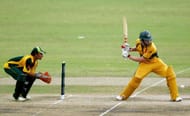
Players of the 2008 U-19 World Cup squad playing in the ongoing World T20: Josh Hazlewood, James Faulkner and Steve Smith
Steve Smith is perhaps the biggest name to come out of Australia’s U-19 squad, and his rise in the last eight years from a leg-spinner who batted at No. 8 to one of the world’s best batsmen and the Australian captain has been unbelievable. Despite being his team’s third highest run-getter, Smith had a sombre U-19 World Cup and failed to flatter due to his technical deficiencies.
While his bowling continued to be on par with some of the best (he picked up 11 wickets at 14.81 during the ICC World T20 2010), he disappeared into the sidelines and got his act together.
Smith returned a couple of years later with a stronger technique, and came across as a player who was now adept at playing both spin and pace, and had a wonderfully array of shots in his arsenal. Smith’s first Test hundred came against England in 2013, and he kept going upwards from there on.
His greatest patch however, came during the home series against India in 2014/15 where he plummeted runs against the Indian attack, breaking a bunch of batting records in the process. He took over as Australia’s captain across formats after the retirement of Michael Clarke.
Unlike Smith, who had a quicker entry into the senior side, James Faulkner had to wait for four years to get his international debut. Faulkner’s role in the side was that of an all-rounder who could bowl a variety of deliveries with his left-arm medium pace, and one who could also provide a lot of fire-power batting lower down.
In no time Faulkner gained notoriety as one of the most difficult batsmen to bowl to, a tag compounded by his batting heroics against India in 2013 – a series where he followed up a 29-ball 64 with a century scored off 57 balls.
While Faulkner’s consistent performances over the years have made him a mainstay in Australia’s limited overs setup, the same can’t be said about Josh Hazlewood, who often finds himself at the wrong side of selection calls. A fast-bowler on the lines of Glenn McGrath, Hazlewood burst into the scene as a 19-year old, making his one-day international debut against England in 2010, a little more than two years after his U-19 World Cup appearance.
While Hazlewood had to wait until 2013 to add to his one-day tally, and to make his T20 debut – his true calling came in the form of Test matches. Hazlewood made his Test debut in 2014, but showed his true brilliance in 2015 when he picked up 51 wickets in the calendar year.
Sadly enough, Hazlewood has played just 5 T20Is in three years, and got overlooked for the game against New Zealand at Dharamsala on Friday, despite picking up a hat-trick agains tthe West Indies in one of the warm up games.
#2 Bangladesh
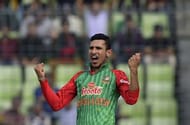
Players of the 2008 U-19 World Cup squad playing in the ongoing World T20: Nasir Hossain
Nasir Hossain was one of Bangladesh’s brightest stars of the U-19 World Cup, where he scored 120 runs at an average of 40, and also picked up 4 wickets at sixteen a piece in the five games that he played.
An exciting lower-middle order batsman and a fantastic fielder, Nasir made his international debut for Bangladesh in 2011. He caught people’s attention in that debut game itself when he scored 63 runs against a decent Zimbabwean attack, thereby also claiming the record of the highest score on debut by a Bangladeshi batsman in ODIs.
His first three seasons in international cricket were impressive, but things went downhill there on. After mediocre performances for two seasons straight, he was dropped from the international squad. However, a strong domestic showing ensured that he made a surprise re-entry into the Bangladesh side for the ICC World T20 2016.
Hossain has represented Bangladesh in 104 matches across formats, and has scored 2572 runs at an average of over thirty, with two international hundreds and 34 wickets.
#3 India

Players of the 2008 U-19 World Cup squad playing in the ongoing World T20: Virat Kohli and Ravindra Jadeja
The rise and rise of Virat Kohli has been well documented in the cricketing universe. A brash, in your face 19-year-old went on to amaze all with his performances in the U-19 World Cup. A lucrative IPL contract and an India call-up followed, taking the media attention in a cricket frenzy nation to the next level. With so much attention affecting the youngster, cricket took a backseat and questions about his temperament were raised.
But all those questions were laid to rest when Kohli became one of India’s shining lights in the 2009 Champions Trophy. He followed it up with his maiden international century against Sri Lanka in Kolkata, and things have never looked bleak for the Delhi boy since. Never since Sachin Tendulkar, has any player been under as much pressure to deliver as Virat Kohli has in the recent past. But he’s taken to pressure like a fish to water, notching up hundreds across the world.
In 252 international games for India, Kohli has scored 11,652 runs at an average of 50. These numbers also include 36 international hundreds, out of which 25 were scored in one-dayers – making him the most successful in the class of 2008. Barring England and West Indies, Kohli has scored runs with pomp in all conditions under all kinds of circumstances. Currently, he is the heir apparent to India’s limited-overs captaincy, and has already made a mark as a Test captain, winning a Test series in Sri Lanka after decades.
While Virat Kohli has had mass acceptance all throughout, Ravindra Jadeja’s place in the Indian squad has often been under scrutiny and subject to ridicule. It was in fact Jadeja, who played a huge role in ensuring that captain Kohli had a bowling attack he could depend on during the U-19 World Cup in Malaysia. Jadeja, a “veteran” of two under-19 World Cups made his international debut for India in 2009 and struck a half-century against Sri Lanka in a losing cause.
He rose in the ranks, and soon became the go-to person for captain MS Dhoni and also went on to play for his captain’s side in the IPL. Jadeja’s role in the team has been that of a wicket-taker in Tests and a controlling option in limited-overs. His brightest moment came at Lord’s where he scored a counter-attacking 74, blowing the wind out of the English bowling attack and helping India move forward towards a historic win.
The left-handed all-rounder from Saurashtra has also been quite a handful on Indian decks where he ran through Australia in 2013 and South Africa in 2015, to help his side register clinical series victories on both occasions.
#4 New Zealand
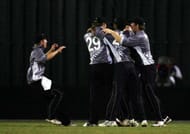
Players of the 2008 U-19 World Cup squad playing in the ongoing World T20: Kane Williamson, Corey Anderson, Trent Boult and Tim Southee
In the semi-final of the U-19 World Cup 2008, Virat Kohli and Ravindra Jadeja went up against a New Zealand side that had four of today’s finest players. It was Corey Anderson, who top scored in that encounter, making 70 off 67 balls. Of the four of them, Anderson was the last to make it to the senior side when he made his T20 debut in late 2012. A batsman who could bowl a bit, Corey Anderson was the quiet performer of the team. He was always known for his powerful striking, but his demeanour kept him in the background.
However, things changed when on New Year’s day in 2014, Anderson blasted his way to a 36-ball ODI hundred, breaking the long-standing record. This blitzkrieg came against West Indies, on the back of a century in only his second Test. All of a sudden Anderson just wasn’t the ‘talented cricketer’, he could deliver as well. Since his debut in 2012, Anderson has played 75 international games for New Zealand, doing reasonably well in Tests and ODIs.
Tim Southee, who played the same semi-final and picked up 4 wickets, went on to become New Zealand’s best exponent of the new ball in recent times. He was perhaps the only one in the class of 2008 who had made his international debut before heading to the U-19 World Cup – Southee already had three ODI wickets when he packed his kit for Malaysia.
When Southee returned from the World Cup as its Player-of-the-Tournament, he had another surprise waiting for him. A Test call-up to replace the injured Kyle Mills. At 19 years and 102 days, Southee made his Test debut against England. His first three victims? Michael Vaughan, Andrew Strauss and Kevin Pietersen. He finished that innings with 5/55 and later on with the bat in hand, hit New Zealand’s fastest Test half-century (in 29 balls).
Southee’s Test debut was a trailer to all the wonderful things he was set to achieve – 7/64 versus India at Bangalore in 2012, 18 wickets at a shade above 17 in the 2011 World Cup, and 28 wickets in 2015 including a spellbinding 7/33 against England during the group stages of the 2015 World Cup.
Someone close on Southee’s heels during the 2015 World Cup as well as the U-19 World Cup was his partner in crime, Trent Boult. Bolt waited for around four years as a fringe player, until he made his Test debut for New Zealand in 2011/12.
In a year’s time, with impressive performances versus West Indies, India and Sri Lanka, Boult became a permanent partner to Southee with the new ball. Bolt became one of the major reasons why New Zealand managed to reach the finals of the 2015 World Cup, one of his memorable spells came against Australia in the group stages.
Current New Zealand skipper, Kane Williamson was also a part of the U-19 World Cup squad. Described by his then coach Dipak Patel as a cut above the rest in terms of work ethics and maturity, Williamson failed to flatter during the tournament. At least not in the manner one would expect him to.
Although he made it to the New Zealand Test squad in March 2010, he had to wait for a few months until he finally got his international debut against India in an ODI. The first outing ended in a 9th ball duck. The second outing against Sri Lanka too, ended in a duck.
With questions being raised on his temperament to perform at the highest level, Williamson silenced his critics with a one-day century against Bangladesh in October that year, becoming the youngest Blackcap to score a hundred. Century in Indian conditions further boosted his profile, and soon Williamson became a talked about player in opposition camps.
Leading up to the 2015 World Cup, Williamson scored nearly 700 Test runs, bringing himself at par with players like Steve Smith and Virat Kohli. In June the same year, Williamson became the fastest to reach 3000 Test runs.
In early 2016, post McCullum’s retirement, Williamson took over captaincy of New Zealand across formats and is currently leading his side in the World T20.
#5 Pakistan
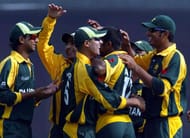
Players of the 2008 U-19 World Cup squad playing in the ongoing World T20: Umar Akmal, Mohammad Amir, Imad Wasim and Ahmed Shehzad
Umar Akmal’s career can only be told in the extremes. One extreme is of a talented youngster who burst onto the scene oozing with confidence and authority, blasting his way to a 129 on debut in New Zealand when everyone else in his team looked like they were batting on a different wicket.
After an average of 45 and 57 in his opening season of international cricket in ODIs and Tests respectively, Akmal treaded into the other extreme. Of that of a misdirected, reckless youngster who threw away his wicket at the most crucial junctures.
Despite all of that, Akmal continues to be one of Pakistan cricket’s better produce of this decade. His patchy form notwithstanding, Akmal has impressed pundits across the globe with his wide array of shots and ability to turn the match on his head.
Adding to Pakistan’s basket of fast-bowling talent, out came Mohammad Amir from the U-19 World Cup. The left-armer who hassled Australia and England in conditions best known to them, became the talk of the town until he decided to do something as dastardly as spot-fixing.
After spending five years in exile, Amir returned in late 2015, stronger, fitter and hungrier than ever before. He ripped through an Indian batting line-up consisting of Rohit Sharma, Shikhar Dhawan and Suresh Raina, before picking up plenty more wickets and ending the Asia Cup T20 as its highest wicket taker.
In the ongoing competition, Amir remains Pakistan’s most potent weapon.
Another player who shot to fame through the U19 World Cup is Pakistan’s Ahmed Shehzad. Shehzad was the earliest of the lot to make his international debut, getting his first international game against Australia in April 2009. He went on to play the 2009 World T20 but it was in 2010 that he showed his true ability, by putting up a good show for Pakistan in limited overs format.
After an indifferent 2011 World Cup, Shehzad was dropped without giving much chance. It took him two years to make a comeback into the Pakistani setup. He celebrated the comeback with a century against South Africa at Port Elizabeth, helping his team become the first Asian side to win a one-day series in South Africa. Soon after, he made his Test debut but failed to hold on to his place in all three formats for a consistent period.
An intervention by the new Pakistani selection panel brought him back into the World T20 squad in place of Khurram Manzoor.
The captain of the U-19 World Cup team, Imad Wasim, had to wait for more than 7 years to earn the Pakistani jersey, making his debut in July 2015. In less than a year, Wasim has played fifteen internationals for his country, picking up fifteen wickets, and scoring a solitary half-century.
#6 South Africa
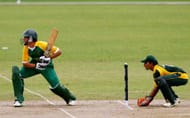
Players of the 2008 U-19 World Cup squad playing in the ongoing World T20: Rilee Rossouw
Rilee Rossouw made a nightmarish start to his international career in 2014 after going largely unnoticed during South Africa U-19’s 2008 World Cup campaign. He made four ducks in his first six innings in international cricket, but the management persisted with him due to his abundant talent.
Rossouw repaid the faith by scoring a century against the West Indies in the game where AB de Villiers brought the roof down with his fastest hundred. Rossouw has remained a part of the South African unit, and has played 43 limited overs internationals and has scored 2 centuries and 4 half centuries in ODIs.
#7 Sri Lanka
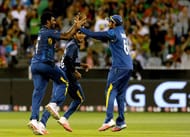
Players of the 2008 U-19 World Cup squad playing in the ongoing World T20: Dinesh Chandimal, Lahiru Thirimanne and Thisara Perera
Thisara Perera made his one-day international debut in the same game in which Virat Kohli scored his maiden ODI century. A hard-hitting, seam bowling all-rounder, Perera has an outstanding record against Pakistan, having won Man-of-the-Series on two occasions in 2012 and 2014. It’s mostly been his attacking cameos lower down the order that has won his team matches.
Cricket’s most audacious innings came off the bat of Dinesh Chandimal when he took Sri Lanka from a position of loss to an unlikely win, with a counter-attacking masterclass versus India in August 2015.
High points in his career include centuries against India and England in just his first five games, and an aggregation of 630 runs spread across two series played in South Africa and Australia in 2012. Chandimal’s performances with the bat have come with his wicket-keeping skills, that have been seen to be safe and dependable.
Currently, Chandimal is the vice-captain of the Angelo Matthews led Sri Lankan side in the World T20.
Like Ahmed Shehzad, Lahiru Thirimanne is another member of the class of 2008 who was brought into the World T20 2016 squad last minute. Thirimanne made his debut for Sri Lanka in 2010, and took a couple of years to settle down. It is his ability to bat at different places in the batting order that makes me a lucrative option for the Sri Lankan cricket team.
The Under-19 World Cup saw Thirimanne score 156 runs with a high score of 68. Between then and now, he has amassed nearly 4,000 runs in over 150 international outings for Sri Lanka.
Follow IPL Auction 2025 Live Updates, News & Biddings at Sportskeeda. Get the fastest updates on Mega-Auction and cricket news
